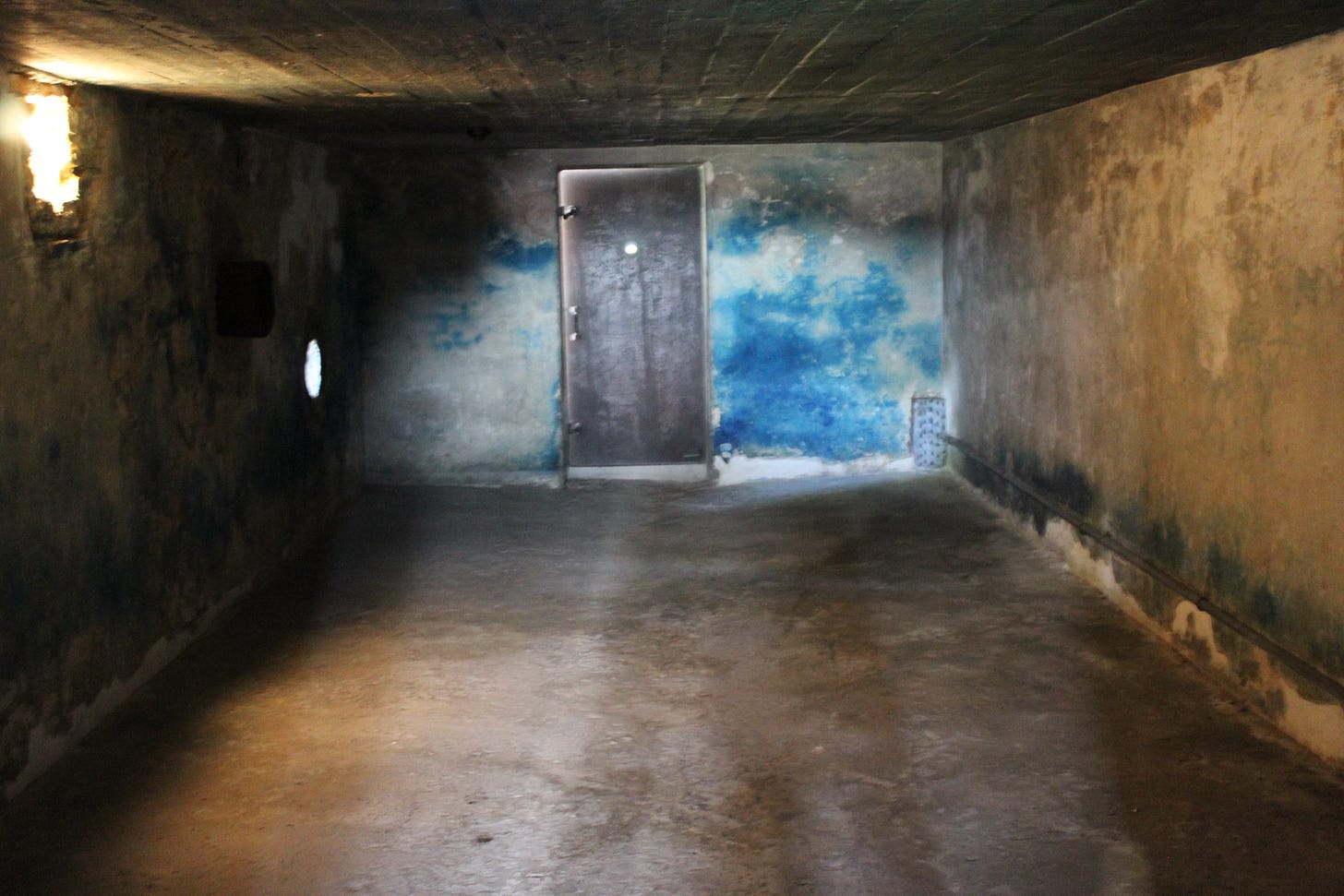This week, at the kind invitation of Rabbi Harvey Belovski, I’m participating in March of the Living, which began yesterday in Warsaw at the Umschlagplatz—the railway holding area where Jews were rounded up for deportation—and took in multiple monuments to the named and nameless Jewish people who lived and worked in the nearby ghetto, and who died in the uprising in 1943 after learning of the extermination camps in late 1942. It is estimated that around 300,000 Jews from the ghetto were murdered at nearby Treblinka and many perished of the terrible conditions of the ghetto itself (a space of 3.3 square km) even before they were deported en masse to their murders.
One of the difficulties of historical imagination is trying to imagine the existence of something that leaves behind very little trace. The leveling of the Warsaw ghetto following the uprising means that, beyond a few memorials, nothing really remains (there are, however, impressive attempts to recreate what life was like for Jews in Poland over hundreds of years, including before WWII in the city’s Polin museum).
This question of historical imagination recurs in a different way upon visiting Majdanek, originally a POW camp established by Himmler, then a labor and then (from 1942) an extermination camp. Unlike many of the other extermination camps, Majdanek is (and was) in clear view of nearby Lublin. It was left relatively intact when the Soviets liberated it in July 1944, and some of the buildings have been restored: the concrete gas chambers and crematoria in any case remained, despite the attempts of fleeing SS officers to burn them down. While many of the camp residents were shot, it is estimated that 300,000 people died at Majdanek, with Jews making up 40 percent of the figure. Poles, Soviets, French, Dutch, German, Italian and Austrian political prisoners also died there.
The camp takes up an enormous amount of land, now left open to visitors, with a large memorial at the entrance. There is controversy over the vast amount of human remains—ashes—which are all piled up together in a (currently closed) memorial. The dead are not individuated, nor properly buried. Gigantic piles of shoes are left in one of the barracks. Is it better to represent unimaginable horror or to point instead to the unrepresentable? Invoking numbers never does justice to death and risks falling into the same framework of quantification and bureaucratization that culminates in systematic mass murder in the first place. This weekend at Birkenau and Auschwitz we’ll be meeting a few Holocaust survivors. Time marches on but history sinks into the ground.
Latest pieces in Compact
We began the week with Compact fellow, Stephen G. Adubato writing about recent workers’ struggles at Fordham University in relation to Catholic precepts regarding economic justice. Adubato argues that “the reality is that the current structure of the university and the ethos of its curriculum and campus culture don’t exactly lend themselves to forging just treatment of its students and workers—at least, not according to the Catholic Church’s definition of justice.”
Ashley Frawley analyzes contemporary eugenics in the shadow of assisted dying, an increasingly widespread practice. Frawley describes the “misanthropology” of ruling elites across the twentieth century, culminating in our own era as concern for “mental hygiene.” Frawley notes that “we no longer talk of poor breeding and imbeciles, but our good aristocrats tell us about the importance of brain development in the first years for the prevention of personal and social problems; our mindfulness gurus locate ‘the most pressing problems of society at their very root—at the level of the human heart and mind.’” In the shadow of the destruction of European Jewry, where “undesirables” deemed too old or unfit to live were murdered in their thousands, Frawley’s piece is a reminder that ruling elites and their inhuman systems are prone to murder. Whether we oppose these killings on democratic or religious grounds makes little difference if we are not able to analyze what’s happening in the first place. Contemporary culture’s obsession with “mental health” should alarm us all.
Next we published Darel E. Paul’s response to the Biden government’s amendment to Title IX, tracing the continuity of policy between the Obama administration and the current rule. Yet there are subtle and important differences. Paul writes: “For the first time, a de minimis harm standard will be applied to any recognition of sex differences in American education.” Paul’s article is a sober and important analysis of just how out of step Biden’s administration is on the question of the reality of sexual difference—with voters, but also with the rest of the world, as the recent UK Cass reportmakes clear.
Playwright Matthew Gasda riffed on Anthony Galluzzo’s recent book After the Vortex (which I also discussed—and recommended—in an earlier Substack newsletter). Gasda reads Galluzzo’s meditation on technology and the ruling class—read through the lens of the strange cult John Boorman film, Zardoz (1974)—in the context of our experience of the contemporary city: “A semi-permanent underclass of migrants serves the upper middle class of tech, finance, law, medicine, and government.” Galluzzo’s work asks us to wonder, Gasda notes, how we can address “the damage we have done to our own natures, in other words, without generating new fantasies, delusions, fraudulent utopias?”
Next we had critic Adam Lehrer on the nobility of Iranian bodybuilder Hadi “The Persian Wolf” Choopan. Lehrer notes: “Bodybuilding, as a modern-day zoorkhaneh, is his code of honor, a code according to which the champion must serve the poor, the widow, the helpless. That he sees as serving his entire country. When he won the Olympia in 2022, thousands of his compatriots went to the airport to greet and cheer for him. He used his victory speech as a way to speak out against his nation’s treatment of women. He is a genuinely courageous man.”
In the context of the widespread student occupations across the US, we published Nobel prize-winner Oliver Hart and Luigi Zingales on the matter of investment transparency, one of the issues at stake for the students protesting over Gaza. The pair write: “investment decisions can’t be left in the hands of professionals who are compensated based on financial performance. That is tantamount to abandoning any moral values in the name of the god Mammon, something very unfitting for higher-education institutions that should lead by example.”
Finally, we round off the week with Cole Aronson on “The Folly of Mob Politics.” Here Aronson argues that, despite recent cinematic depictions, “civil war is highly unlikely.” Aronson suggests that, in the context of on-going occupations and protests, a more credible danger “is a national demand for excessive policing of our public life, in the name of public safety, by that highly coordinated state. The therapeutically minded bureaucrats in our government, universities, and corporations wish for nothing more than to further sedate our public debates, to further constrain the range of permissible thought and speech.”
Nina Recommends
Going outside! The weather finally turned a corner in London this week—well, okay, there was a massive storm at 3 a.m. the other day and the upside-down dish-like feeling hasn’t quite departed fully—but Spring is here, more or less, and Beltane on May 1st marked the beginning of Summer in Ireland and other Gaelic places, so even the melancholic get to see the sun occasionally.
Until next week—Nina









May is a funny month
Here it is
From Canada's London
https://open.substack.com/pub/davidmacgregor/p/how-to-start-a-rainy-may-3rd-morning?r=patn2&utm_campaign=post&utm_medium=web&showWelcomeOnShare=true